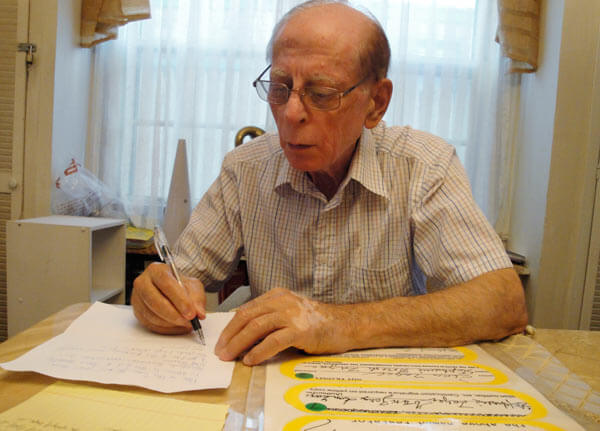By Colin DeVries
With each seemingly mindless cross of a “t” or dot of an “i,” the deepest psychological characteristics of the writer’s subconscious are revealed — at least that’s what Dr. Elias Samas will tell you.
Around the holidays each year, Samas eagerly awaits the arrival of greeting cards sent by loved ones from afar. The 78-year-old handwriting expert examines each heartfelt message of yuletide blessings with the greatest of care, parsing all the inscribed notes with a sharp, analytical eye, but without seeing a single word.
“When I get holiday cards, I don’t read them. I just like to see how people are doing,” the Jamaica resident told a small handwriting analysis class in the basement of College Point’s Poppenhusen Library.
One letter of the alphabet, Samas said, can provide more than 30 interpretations of an individual’s mental condition. By simply noting the placement of a writer’s “t” crossbar, a graphoanalyst can discern how the writer’s well-being may have changed from a year earlier.
A high t-bar indicates a strong will and a positive outlook for the future. A low t-bar, or one that is curved or shortened, may show signs of depression, confusion or frustration. A “t” with a centered crossbar indicates an individual with practical goals, while a t-bar that is not fully formed may indicate procrastination.
As a student of psychology, Samas became interested in graphoanalysis, or the practice of handwriting analysis, as a vehicle toward a better understanding of people and the human condition.
“You can get as much information from a psychological test as a sample of handwriting,” said the Alexandria, Egypt, native, who immigrated to the United States in 1967, studied psychology at Columbia University and eventually earned a doctorate. He went on to earn a certificate by mail through the International Graphoanalysis Society when it was located in Chicago during the late 1960s.
As president and founder of the Queens Graphoanalysis Center, Samas has applied his expertise in a variety of capacities since being certified. While much of his work has involved testifying before court on civil matters involving forgeries or contract disputes, he is on occasion called upon to provide insight on high-profile cases, including an examination of the ransom note in the mysterious, unsolved killing of JonBenet Ramsey, a 6-year-old Colorado beauty queen whose death gripped the hearts of a nation.
In 1977, when a serial killer was terrorizing New York City and writing cryptic, rambling letters to police and the media, Samas said he might have known the killer. He found similarities in the Son of Sam’s handwriting with that of a patient he was counseling.
“He matched most of the traits,” Samas told Newsday in 2000, noting the bizarre religious symbols he observed on the patient’s walls when he went to see him after the discovery. “I got really scared then. There were a lot of similarities .… But the next day they caught the real killer. So I didn’t save humanity that time.”
To Samas, handwriting reveals the innermost qualities of a person, including his or her individuality.
“Handwriting is like fingerprints: No one can imitate your handwriting,” he said. “Whether your mouth, your foot or your hand, your writing will reveal the same characteristics.”
The slightest loop in a “y” or slant of a t-bar can expose even the most cunning of forgers.
Samas was once asked by the National Enquirer to compare the signatures of crooner Frank Sinatra. Though many of the same nuances remained from Ol’ Blue Eyes’ 1940 autograph to his others in 1951, 1965 and 1982, some changes in horizontal slant revealed his demeanor had remarkably transformed.
“Sinatra’s handwriting reveals he was more domineering, close-minded and secretive when he was young,” Samas told the Enquirer. “But now that he has matured, he’s more honest, open-minded and talkative.”
Handwriting, however, can also act as a self-fulfilling prophecy, Samas said. If a person consciously works at changing the way letters are written, he said, it may command the writer’s personality — making the case for keeping “i’s” neatly dotted and t-bars high and strong.

































